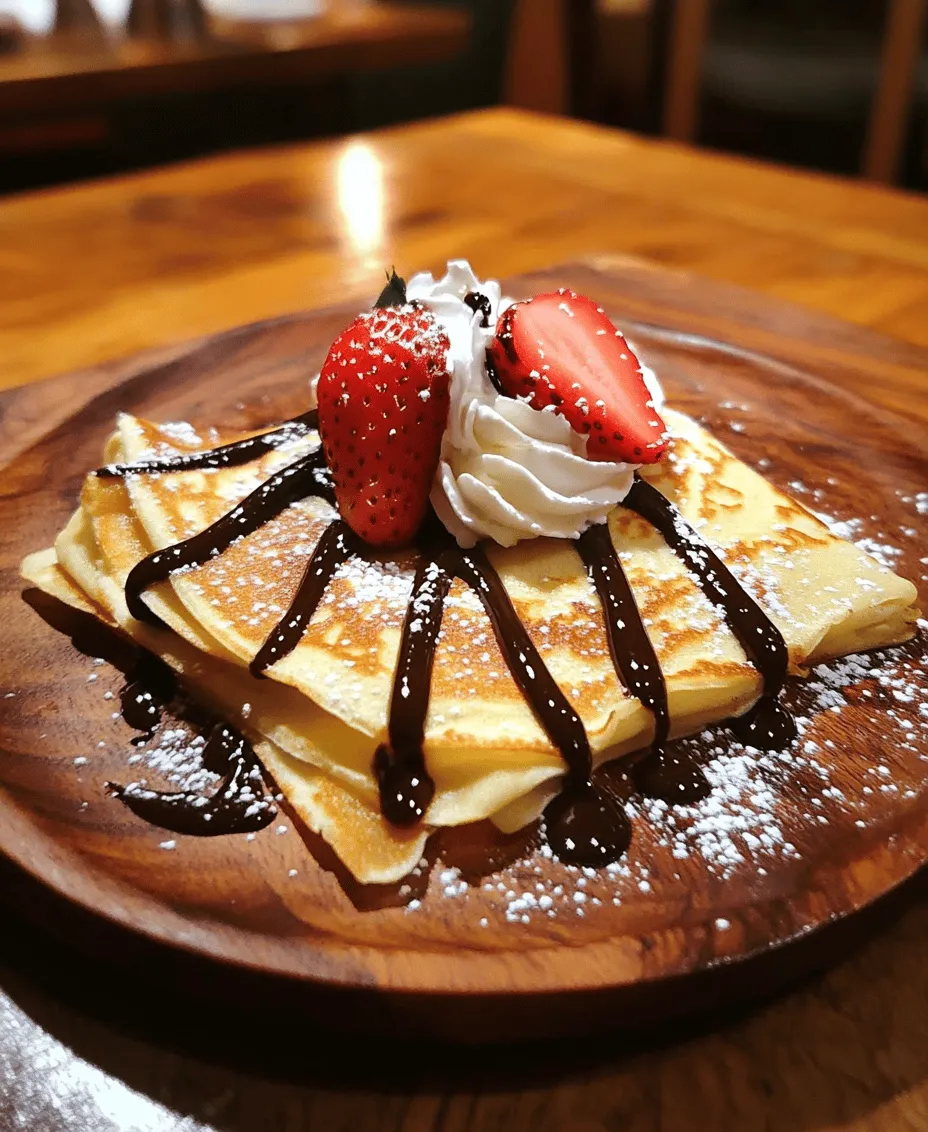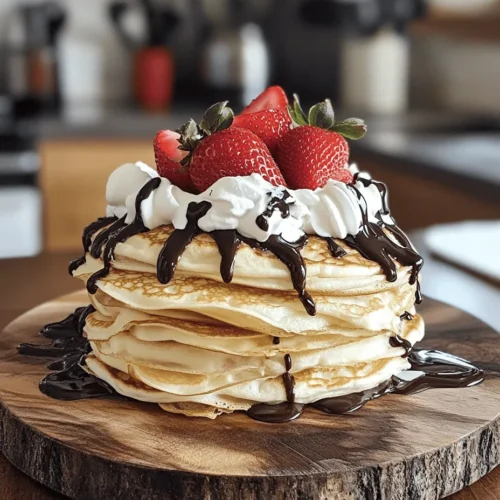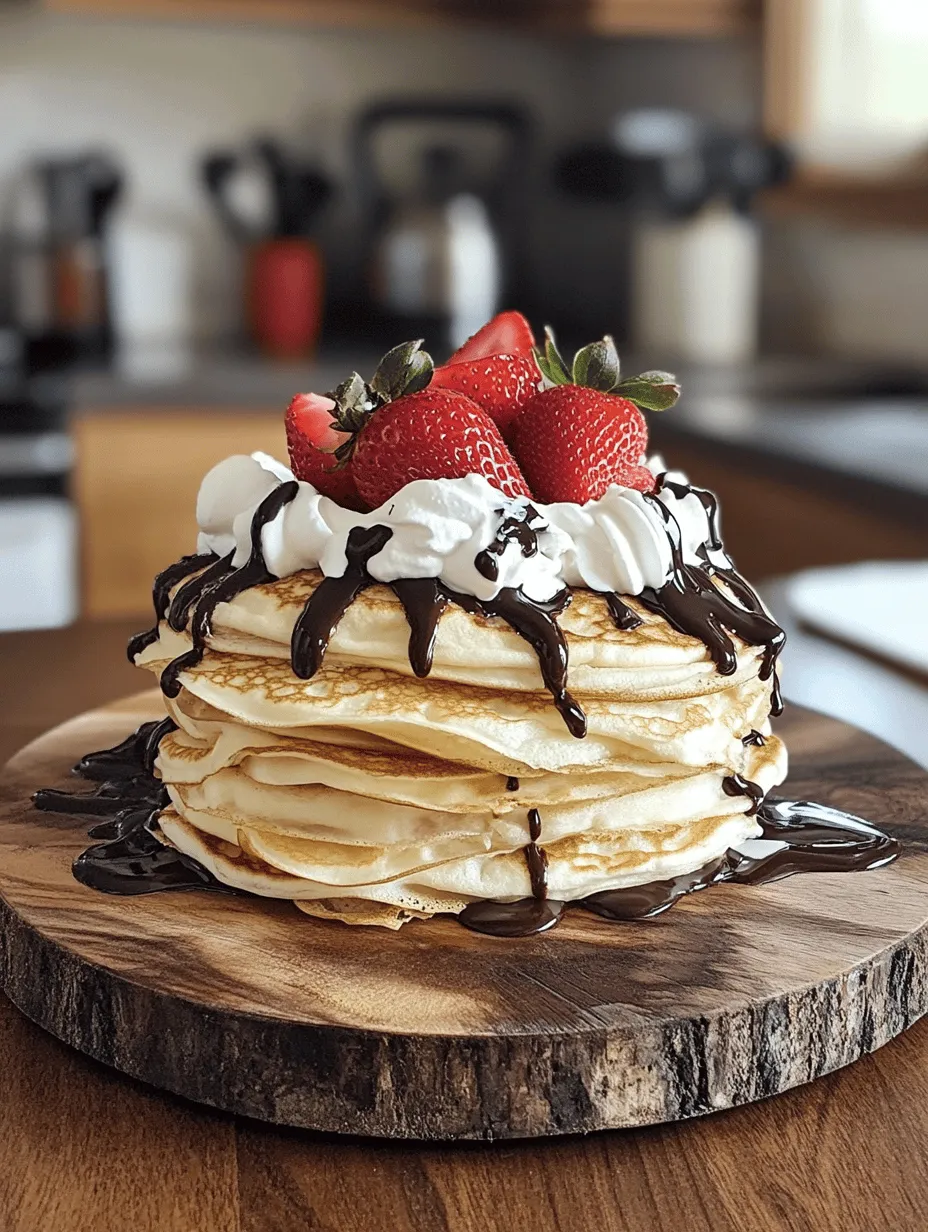The Art of Crepe Making
Crepes are a culinary delight that have charmed their way into kitchens and hearts around the world. Originating from France, these thin pancakes have a rich history that dates back to the 13th century. Initially, crepes were made from buckwheat flour and served as savory galettes. However, as the recipe evolved, it transitioned to using all-purpose flour, paving the way for the sweet variations we know and love today. Crepes have since become a staple in various cuisines, from the classic French dessert crepes Suzette to the deliciously sweet banana nutella crepes that are a favorite among many.
One of the most beloved variations is the vanilla crepe. These delicate, buttery pancakes offer a subtly sweet flavor that pairs beautifully with a wide range of fillings and toppings—be it fresh fruit, whipped cream, or even a drizzle of chocolate sauce. The magic of vanilla crepes lies not only in their delightful taste but also in their simplicity and versatility. Whether you are preparing a Sunday brunch for family or impressing guests at a dinner party, vanilla crepes can elevate any meal with minimal effort.
In this article, we will guide you through the process of making delightful vanilla crepes from scratch. With just a handful of ingredients, you will create a dish that is sure to impress. The recipe is straightforward, making it accessible for both novice cooks and seasoned chefs alike. So, let’s get started on this delicious journey of crepe making!
Understanding the Ingredients
To prepare delightful vanilla crepes, it is essential to understand the role of each ingredient involved. The harmony of these components is what ultimately results in the perfect crepe. Below is a detailed overview of the main ingredients you will need:
All-Purpose Flour: The Backbone of the Crepe Batter
All-purpose flour is the foundation of your crepe batter. It provides structure and stability while allowing the crepes to be thin and pliable. The type of flour you choose can significantly affect the texture of your crepes. All-purpose flour is ideal because it has a balanced gluten content, resulting in a tender crepe that can hold its shape without becoming tough.
Eggs: Binding Agent and Enhancer of Texture
Eggs play a crucial role in crepe making. They act as a binding agent, helping to hold the batter together. Additionally, eggs contribute to the overall texture by providing moisture and richness. The proteins in eggs coagulate when cooked, giving the crepes their characteristic soft yet sturdy structure. For best results, use large eggs, as they provide the right amount of moisture and binding properties.
Milk: Key to Achieving the Desired Consistency
Milk is another fundamental ingredient in the crepe batter. It hydrates the flour, allowing the gluten to develop properly, and creates a smooth, thin batter. The fat content in milk also adds richness, enhancing the flavor of the crepes. You can use whole milk for a creamier taste or opt for skim milk if you prefer a lighter option. For a dairy-free version, almond milk or oat milk can be excellent substitutes.
Butter: Adds Richness and Flavor
Butter is essential for flavor and texture in your vanilla crepes. It imparts a rich, buttery taste that enhances the overall experience. Additionally, melted butter adds fat to the batter, making the crepes pliable and preventing them from sticking to the pan while cooking. Using unsalted butter is recommended, as it allows you to control the saltiness of your dish.
Sugar: Balances Flavors and Contributes to Browning
A touch of sugar is added to the batter to enhance the sweetness of the crepes. It not only balances the flavors but also aids in the browning process, resulting in beautifully golden crepes. Granulated sugar is commonly used, but you can experiment with alternatives like honey or maple syrup for a more distinct flavor profile.
Vanilla Extract: Enhances the Overall Taste
Vanilla extract is the star ingredient in vanilla crepes. It infuses the batter with a warm, aromatic flavor that elevates the crepes from ordinary to exceptional. Opt for pure vanilla extract for the best results, as imitation vanilla can lack the depth of flavor that real vanilla provides. If you want to take the flavor up a notch, you can also scrape the seeds from a vanilla bean pod and add them to the batter.
Salt: A Pinch to Elevate All Flavors
A small amount of salt is crucial in any recipe, including vanilla crepes. It enhances the sweetness and balances the flavors of the other ingredients, making the overall dish more flavorful. Just a pinch can make a significant difference, so don’t skip this step!
Step-by-Step Instructions for Perfect Crepes
Now that you have a good understanding of the ingredients and their roles, let’s dive into the step-by-step instructions for making delightful vanilla crepes. The process is straightforward, but attention to detail is key to achieving the perfect crepe. Here’s how to do it:
1. Mixing the Dry and Wet Ingredients: Importance of Whisking
Begin by gathering all your ingredients and a large mixing bowl. In the bowl, combine the all-purpose flour, sugar, and salt. Whisk these dry ingredients together until they are well blended, ensuring that there are no lumps.
In a separate bowl, whisk together the eggs and milk until smooth. Gradually add this wet mixture to the dry ingredients, whisking continuously to avoid lumps. The goal is to create a smooth batter with a consistency similar to heavy cream. If you notice any lumps, you can use a blender or a hand mixer for a few seconds to achieve a perfectly smooth batter.
2. The Resting Period: Why It Matters for Texture
Once your batter is ready, let it rest for at least 30 minutes at room temperature. This resting period is crucial as it allows the gluten in the flour to relax, resulting in more tender crepes. Additionally, the resting time helps the bubbles in the batter settle, which leads to a smoother texture when cooking.
3. Cooking the Crepes
When you’re ready to cook, heat a non-stick skillet or crepe pan over medium heat. To ensure the pan is hot enough, you can sprinkle a few drops of water on the surface; if they dance and evaporate quickly, the pan is ready.
Before pouring in the batter, lightly grease the pan with a small amount of melted butter. Use a ladle to pour about 1/4 cup of batter into the center of the pan. Immediately tilt and swirl the pan to spread the batter evenly into a thin layer that covers the bottom of the skillet.
Tips for Achieving the Ideal Heat Level
Maintaining the right heat level is essential for cooking crepes. If the heat is too high, the crepes may cook too quickly and burn, while low heat can result in undercooked crepes. Aim for a medium heat setting, and adjust as needed while cooking.
Techniques for Flipping the Crepes Without Tearing
After about 1-2 minutes, you’ll notice the edges of the crepe starting to lift and the surface appearing set. This is your cue to flip! Use a spatula to gently lift the edge of the crepe, and then use your fingers (if you’re comfortable) or the spatula to flip it over. Cook the second side for an additional 30 seconds to 1 minute until it is lightly golden.
Visual Cues to Know When Each Side is Done
Pay attention to the color and texture of the crepes as they cook. The first side should be golden brown, while the second side will be slightly less cooked. This difference is normal and adds to the character of the crepes.
4. Stacking and Keeping Warm: Best Practices for Serving
As you cook each crepe, stack them on a plate. To keep them warm, you can cover the stack with a clean kitchen towel or foil. If you’re preparing a large batch, consider placing the stack in a low-temperature oven (around 200°F or 93°C) until you’re ready to serve.
With your delightful vanilla crepes cooked and stacked, you’re now ready to fill them with your favorite toppings and fillings. From fresh berries and whipped cream to a simple dusting of powdered sugar, the possibilities are endless. Enjoying a delicious plate of homemade vanilla crepes is a rewarding experience that is sure to leave you and your guests satisfied.

Serving Suggestions: Elevating Your Crepe Experience
Vanilla crepes are a versatile dish that can be enjoyed in numerous ways, allowing for both sweet and savory adaptations. Here are some popular fillings and toppings that will elevate your crepe experience, making them suitable for breakfast, dessert, or even a light lunch.
Popular Fillings for Vanilla Crepes
Fresh Fruits
One of the simplest and most delightful ways to enjoy vanilla crepes is by adding fresh fruits. Strawberries, bananas, and a medley of berries are particularly popular choices. The natural sweetness and acidity of these fruits complement the delicate flavor of the crepes perfectly. Consider slicing ripe bananas and layering them inside the crepe with a sprinkle of cinnamon for an extra flavor boost. Alternatively, a combination of strawberries and blueberries can add a refreshing, vibrant touch.
Sweet Toppings
For those with a sweet tooth, topping your crepes with whipped cream, chocolate sauce, or caramel will create an indulgent treat. A drizzle of high-quality chocolate sauce can transform your crepe into a dessert worthy of any café. If you prefer something lighter, a dollop of freshly whipped cream paired with a sprinkle of powdered sugar can enhance the crepe without overwhelming it. For a more gourmet touch, consider infusing the whipped cream with a hint of vanilla or almond extract.
Savory Options
While sweet crepes are typically the star, savory variations can be just as satisfying. Fill your crepes with sautéed spinach and a blend of cheeses, such as ricotta or goat cheese. This combination not only creates a delicious meal but also adds nutritional value with greens and protein. You can also try incorporating cooked mushrooms and a dash of garlic or even thinly sliced smoked salmon with cream cheese for a more sophisticated twist.
Combination Ideas for Creating a Balanced Meal or Dessert
For a complete meal, consider pairing sweet and savory fillings. A crepe filled with spinach and cheese can be followed by a dessert crepe filled with strawberries and whipped cream. This way, you can provide a balanced dining experience that caters to all palates. Alternatively, create a crepe platter with a variety of fillings and toppings, allowing guests to customize their own delicious creations.
Nutritional Information: A Balanced Treat
Understanding the nutritional content of your vanilla crepes can help you enjoy them guilt-free. Typically, a serving of a basic vanilla crepe (one crepe) contains:
– Calories: Approximately 90-120 calories
– Protein: About 3g
– Fat: 3-5g
– Carbohydrates: 14g
– Fiber: 0.5g
– Sugar: 1-3g
Discussion on Dietary Considerations
For those with dietary restrictions, there are several alternatives to make vanilla crepes more inclusive. Gluten-free flour blends can replace all-purpose flour, allowing those with gluten sensitivities to enjoy this delightful dish. Additionally, dairy substitutions like almond milk or coconut milk can be used in place of regular milk. To make the recipe vegan, substitute eggs with flaxseed meal mixed with water or use a commercial egg replacer.
How to Enjoy Crepes as Part of a Balanced Diet
Crepes can be integrated into a balanced diet by being mindful of the fillings and toppings used. Opting for fresh fruits and nuts can provide essential vitamins and minerals, while using healthier sweeteners like honey or agave syrup instead of refined sugar can enhance their nutritional profile. When enjoyed in moderation and with the right fillings, crepes can be a delightful addition to a balanced diet.
Culinary Tips and Techniques for Mastering Crepes
Making the perfect crepe may seem daunting at first, but with practice and a few tips, you can master this culinary technique.
Common Pitfalls and How to Avoid Them
One of the most common pitfalls in crepe-making is ending up with a batter that is too thick. A thin, pourable batter is crucial for achieving the delicate texture of crepes. If your batter seems too thick, simply add a little more milk to reach the desired consistency. Additionally, allow the batter to rest for at least 30 minutes before cooking; this helps the gluten relax and leads to more tender crepes.
Another common issue is uneven cooking, which can result in crepes that are burnt in some areas and undercooked in others. To avoid this, use a non-stick skillet or a well-seasoned crepe pan, and ensure that the pan is preheated properly before pouring in the batter. A quick swirl of the pan will help achieve an even layer of batter.
Alternative Cooking Methods
While a traditional skillet is the most common method for cooking crepes, using a dedicated crepe maker can make the process even easier. Crepe makers provide uniform heat and often come with a spreader to help you achieve the perfect thinness. If you don’t have a crepe maker, you can also use a well-heated griddle or even an electric frying pan.
The Importance of Practice in Perfecting Crepe-Making Skills
As with any culinary skill, practice is key to mastering crepe-making. Don’t be discouraged by initial failures; even professional chefs have off days. Keep experimenting with different batter recipes and cooking techniques until you find a method that works best for you. Over time, you’ll develop an intuition for the right batter consistency and cooking time, leading to beautifully crafted crepes every time.
Cultural Variations: Crepes Around the World
Crepes are beloved worldwide, and different cultures have embraced this dish in unique ways.
French Crêpes: The Classic Approach
In France, crepes are often enjoyed in both sweet and savory forms. Sweet crêpes, typically made with white flour, are filled with a variety of ingredients, including Nutella, fruit preserves, or simply a sprinkle of sugar and lemon juice. Savory galettes, made with buckwheat flour, are filled with ingredients like ham, cheese, and eggs, showcasing the versatility of this dish.
Latin American Tortillas: Similarities and Differences
In Latin America, the concept of crepes is mirrored in tortillas, which are made from corn or wheat flour. While tortillas are thicker and sturdier than French crepes, they serve as a base for a variety of fillings, including meats, beans, and vegetables. Both dishes highlight the cultural significance of flatbreads in different culinary traditions.
Asian Variations: The Influence of Rice Flour Crepes
In Asian cuisines, rice flour is often used to create crepe-like dishes. For instance, Vietnamese bánh xèo are savory rice flour crepes filled with shrimp, pork, and bean sprouts, while Korean jeon are made with a variety of ingredients and served as a side dish. These variations illustrate how the crepe concept transcends cultures, inspiring creativity in fillings and presentations.
How Cultural Influences Can Inspire Creativity in Crepe Fillings and Presentations
Exploring global variations of crepes can inspire you to think outside the box when it comes to fillings and presentation styles. For example, you might experiment with Asian-inspired fillings like spicy kimchi and tofu or create a Mediterranean version using feta cheese and olives. The possibilities are endless, and each cultural influence can add a new dimension to your culinary creations.
Conclusion: The Joy of Making and Sharing Crepes
Making vanilla crepes is not just about creating a delicious dish; it’s about the joy of cooking and sharing with others. Whether you’re filling them with fresh fruits, decadent sauces, or savory ingredients, each crepe becomes a canvas for your culinary creativity.
As you explore different flavors and fillings, remember that the heart of this dish lies in the experience of making it together with family and friends. Invite loved ones into the kitchen to create their own personalized crepes, fostering connection and memories over shared meals.
So roll up your sleeves, grab your favorite ingredients, and embark on a delightful culinary adventure with vanilla crepes. The joy of crafting these delicate treats is only rivaled by the happiness they bring when shared with others.



